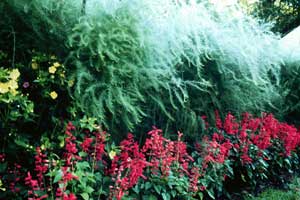The care information provided in this section represents the kind of practical advice is available for all the plants in this web site if you subscribe to the monthly customized newsletter Yardener’s Advisor.
Watering and Fertilizing
As a rule annuals have fairly shallow root systems and they dry out more quickly than well-established perennial plants and shrubs. Red salvias like moist soil, so if they are planted in thin soil with little organic content, or they are not mulched, they may need supplemental watering during the hot summer if rainfall is sparse. Do not allow the soil to become water-logged.
 |
Mulching
Many plants benefit from mulching, especially those that grow in the hot sun which dries out the soil quickly. Spread a 2 or 3 inch layer of some organic material such as dried grass clippings, wood chips, or chopped leaves on the soil around the salvia plants to discourage weeds, help the soil retain moisture and keep the roots cool. As it decomposes, mulch also contributes organic material and the beneficial organisms that live in it to the soil to improve it. For more information see the file on Using Mulch
Pruning/Grooming
Remove faded flower stalks over the season by pinching or clipping them off at the point on the stem where the foliage begins. When seedlings of standard height red salvias are 3 or 4 inches tall you can pinch off their tips to encourage them to branch and become bushy. This is not at all necessary, however.
Tall plants such as red salvia often require staking as the season progresses. Heavy rains, wind, or even overhead watering may knock them down, causing their branches, which get brittle as they mature, to split from the main stem or break. Support individual salvia plants by inserting a straight stick or thin stake into the soil next to the main stem. Choose sticks long enough to meet the salvias’ mature height. Using soft, string loosely tie the main stem of each plant to a stick.

